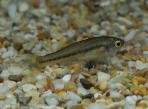Ilyodon cortesae
PAULO-MAYA, J. & P. TRUJILLO-JIMÉNEZ (2000): Nueva especie de Ilyodon (Cyprinodontiformes: Goodeidae) de la cuenca del río Balsas, México. Revista de biologia tropical v. 48, n.2 - 3: pp 1 - 17
Collection-number: IPN-P 4380. The Holotype is an adult male of 46.1 SL. It has been collected by A. Ramírez, J. Paulo-Maya, P. Vallejo and H. Ríos on 10.05.1986
The type location are the Springs of Cutzaróndiro, 13.km SE of the Río San Juan Tacámbaro (19° 10' 42'' N, 101° 20' 45'' W). The type location is about 1463m above the sea-level.
This species is named after Maria Teresa Cortés, who played an important role in the developement of the Mexican Ichthyology.
none
This Ilyodon is only known from the springs and the upper part of the Río San Juan Tacámbaro in Michoacán.
not mentioned
The type location is a spring with clear water, 4x6m in diameter and 1m deep. The ground is made of sand with zones of gravel with patches of Potamogeton sp. and filamentous algae. The water contains about 7.2mg/l disolved oxygen at a pH of 7.5 and 20°C water temperature. The only other fish in this habitat is the Cyprinid Hybopsis boucardi (Guenther, 1868).
There is at the moment no information about the biology of this fish available.
This species possesses strongly implanted bifid teeth with the gap between the two cuspids deeper than in its congeners. Following this fact, Cortes' Splitfin seems to be an omnivorous species, prefering more carnivorous food than Ilyodon whitei or furcidens.
Following the describers, the colouration in ethylic alcool is somewhat dark coffee-brown on the back and lighter on the belly. The sides show a black line made of small points from the end of the operculum to the base of the anal fin. Numerous black marks cover the whole body becoming denser on the posterior part of the fish. The dorsal fin of the males displays 3 longitudinal rows of black dots. The pelvic and pectoral fins are lightly darker.
In life, the ground colour is light brown on the back and lighter on the belly, sometimes yellowish. A dark lateral line is densly composed by dots. The males show many marks on the belly and in the caudal fin. Two or three rows of marks are longitudinally arranged in the dorsal fin. The females show less marks, concentrating in a lateral line. No marks are present in fins. The fins are slightly darker than in males.
Ilyodon cortesae is the smallest Ilyodon species, that does not reach 7cm in total. Some authors think, this species is not distinct from whitei, its nearest relative. The dwarf-size may be the result of the poor available food in their clean habitats, and may be superimposed in tank breeding.
This species is differing from its congeners by its strongly convex cephalic profile, its small size, the thinner caudal peduncle, more scales in the longitudinal series, form and size of the neural prezygapophyses of the caudal vertebrae, the strongly bifid teeth and the disposition of the pores of the lateral line of the preorbital system.
The systematic situation of the genus Ilyodon is very difficult and not solved already. Changes in its phylogeny can be expected for the future.









